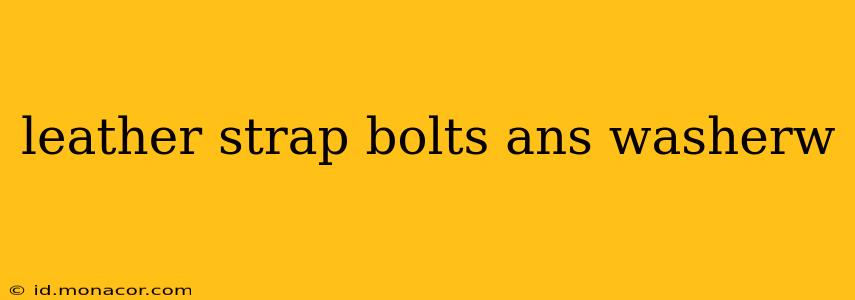Leather Strap Bolts, Washers, and the Art of Secure Attachment
Leather straps, ubiquitous in countless applications from luggage and handbags to saddles and harnesses, rely on robust hardware for secure and lasting attachment. Understanding the crucial role of bolts and washers in this process is vital, whether you're a craftsman, repair specialist, or simply a DIY enthusiast. This guide delves into the specifics of leather strap hardware, offering insights into material choices, sizing, and best practices for a secure and professional finish.
What types of bolts are best for leather straps?
The ideal bolt for a leather strap depends heavily on the application and the anticipated load. For lighter-duty applications like attaching a strap to a bag, a standard machine screw (often steel or brass) with a fine thread might suffice. However, for heavier loads, such as those experienced with saddles or industrial equipment, you'll want to consider high-tensile strength bolts made from materials like stainless steel. These offer superior durability and resistance to shearing forces. The choice also depends on the hole size already present in the leather or the metal component being attached.
What size washers should I use with leather strap bolts?
Washers serve a critical function: they distribute the clamping force of the bolt over a larger area of the leather, preventing damage and ensuring a secure connection. Using the wrong size washer can lead to the leather tearing or the bolt pulling through. The washer should be slightly larger than the bolt head and made of a material that won't damage the leather (avoid sharp edges). Flat washers are generally preferred for leather applications, though flanged washers can offer additional protection against the bolt head digging into the leather. Matching the washer material to the bolt (e.g., stainless steel washer with a stainless steel bolt) is ideal for preventing corrosion.
What are the different types of washers available?
Several washer types offer specialized benefits for leather strap applications:
- Flat Washers: The most common type, providing a simple and effective means of distributing clamping force.
- Flanged Washers: These feature a raised lip that helps prevent the bolt head from digging into the leather. They offer better protection and a more professional look.
- Split Washers (Lock Washers): These provide additional security against loosening due to vibration. Useful for applications where the strap is subjected to significant movement.
- Shoulder Washers: These offer a combination of features found in flat and flanged washers, providing both force distribution and protection against digging.
Are there any specific considerations for using bolts and washers on leather?
Yes, several crucial considerations enhance the longevity and security of your attachment:
- Pre-drilling: Always pre-drill holes in leather before inserting bolts to prevent tearing. Use a drill bit slightly smaller than the bolt diameter.
- Appropriate Bolt Length: Ensure the bolt is long enough to provide sufficient thread engagement into the receiving material while also accommodating the thickness of the leather and washers.
- Countersinking (Optional): Countersinking the bolt head slightly below the surface of the leather creates a smoother, more aesthetically pleasing finish. This requires specialized tools and care.
- Material Compatibility: Choose bolt and washer materials resistant to corrosion, especially if exposed to the elements. Stainless steel is an excellent choice in many instances.
How do I prevent the bolt from pulling through the leather?
Preventing bolt pull-through involves using the correct size and type of hardware, along with proper installation techniques. This includes pre-drilling holes, using appropriately sized washers to distribute pressure, and considering stronger materials for heavy-duty applications. In cases where extra security is needed, employing rivets or reinforcing the hole with leather patches can significantly improve durability.
By carefully selecting appropriate bolts and washers and following best practices, you can ensure a strong, long-lasting, and professional-looking attachment for your leather straps. Remember to always consider the specific demands of your application when choosing your hardware.

